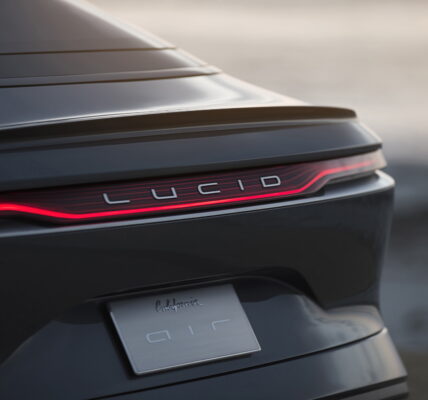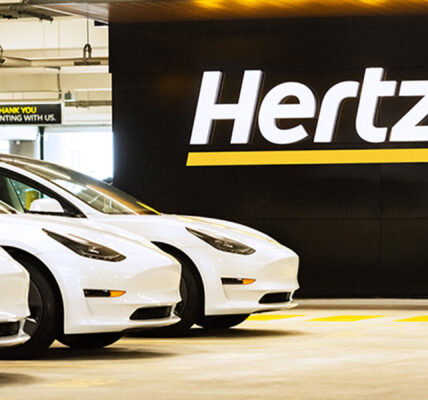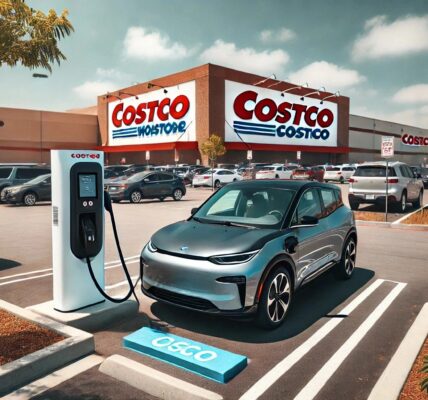In the farthest Denver suburbs, just off Interstate 25 stands a gas station called Kum & Go that doesn’t look like a battle zone. But it is.
One clue is in plain sight as you look around during the boring few minutes it takes to top off your tank. Plopped in the corner of the lot like an afterthought are four vertical red slabs.
They’re electric vehicle charging stations, capable of reviving an EV and its battery in about half an hour. It is no exaggeration to say they could be the most disruptive thing ever to confront that century-old fixture of the American roadside: the gas station. As more Americans drive their shiny new electric vehicles onto the highway and wonder where to go when the battery nears empty, charging stations are the agents of a revolutionary fill-up — not of gallons but kilowatts, not five-minute “stops” but half-hour “experiences” that could completely transform the tenor of the road trip.
These pumps and plugs facing each other across the asphalt are also totems of an unseen battle. Two titans of the energy sector — electric companies and gas stations — have peacefully coexisted for a century but now find themselves vying for the right to serve electric vehicle owners. In just the last nine months, automakers have sold over 576,000 EVs, a 70-per cent jump over the same period last year, according to auto-research firm Kelley Blue Book. A burst of investment in both vehicles and chargers from automakers and the feds suggests that’s just the beginning. Ford and General Motors, America’s two biggest automakers, and the Biden administration have coalesced around a goal of electrifying half of new cars by 2030.
Crucial to that future is a nationwide network of charging stations. Who controls those stations and the fuel coursing through them is the flash point of a fight between the electric utility and the convenience store. The outcome will impact where Americans charge their EVs and how much they pay.
As both gas stations and power companies hang their future on electric vehicle, the fight has gotten ugly. In fact, heads have already rolled. One electric utility, Southern California Edison, forced the resignation of a key lobbyist in order to kneecap the gas station industry as Congress considered President Joe Biden’s bipartisan infrastructure bill, which included $7.5 billion for electric-vehicle charging stations. The spigot of federal dollars only increased with the passage in August of the big federal climate-energy bill, stuffed with incentives to restructure the auto industry around EVs.
This collision between electricity and gasoline is in sharp relief at Kum & Go, a chain of almost 400 filling stations and convenience marts in 11 states that have invited the electric vehicle to disrupt its business model. Wellington is the final settlement of metro Denver before the plains spread north toward Wyoming. Alongside the grind of I-25, next to a McDonald’s, stands the Kum & Go with its sign advertising the latest price for unleaded. It’s one of six Kum & Go stations in the state that have embraced electric vehicle charging. Other gas station chains sometimes host charging stations owned by someone else, often Tesla. But Kum & Go has branded these stations in its red-and-white colour scheme.
In 2018, Kum & Go set the goal of “being known as the place that has EV charging,” said Jacob Maass, the company’s commercial fuel manager. This year, as electric vehicles, have begun to seem inevitable and the Biden administration spends big to construct a network of 500,000 fast-charging stations, some of the country’s biggest fueling chains have joined the parade, including Pilot Co. and 7-Eleven.
But success hinges on resolving fundamental disputes over who has the right to sell electricity, and for how much.
The supply chain that underpins the gas station — starting in the oil fields of Saudi Arabia or Texas and flowing through intermediaries to that big price on the sign — becomes something else entirely in the EV age. What replaces it is a system of stupefying complexity. The price a station host pays for the new fuel is determined by which of America’s 3,000 electric utilities the plugs happen to be connected to. This pricing system is invisible to the driver but presents an existential dilemma for gas station owners. They find themselves at the mercy of an opaque, highly regulated and monopolistic electricity system that is the exact opposite of the one they have thrived on for decades.
EV charging involves “an electricity market structure that was not designed for — and is, not surprisingly, incompatible with — the retail fuel market,” said A.J. Siccardi, a fueling executive, in testimony to Congress last summer that caused sparks between the two camps.
It is possible that gas stations and electric companies will sort through their thicket of disagreements so that gas stations can make money filling batteries, while also (strangely enough) becoming a cool place to hang out. Or it’s possible that the fueling station as we know it will cease to exist, supplanted by battery refills in home garages, at workplace parking lots or at Starbucks, while the driver nurses a venti latte.
In other words, these electric cubes on the Colorado roadside are either the dominoes that trigger the gas station’s revolution or the headstones that mark its grave.








